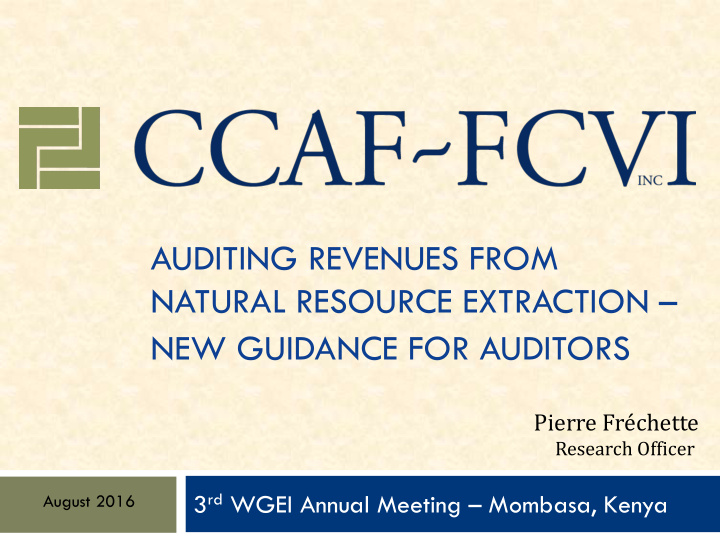



AUDITING REVENUES FROM NATURAL RESOURCE EXTRACTION – NEW GUIDANCE FOR AUDITORS Pierre Fréchette Research Officer 3 rd WGEI Annual Meeting – Mombasa, Kenya August 2016
Overview 1 • What is CCAF? • The Practice Guide Series • Current Project on Auditing Extractive Industries • Scope of the New Practice Guides • Gaps and Questions – How You Can Help Us
What is CCAF ? 2
What is CCAF and What Does it Do? 3 • Canadian non-profit organization • Operating since 1980 • Our Mission: “To promote and strengthen public sector performance audit, oversight and accountability in Canada and abroad through research, education and knowledge sharing”.
Our Programs 4 • International programs • Fellowships and mentoring • Workshops and capacity assessments • National programs • Audit Methodology • Workshops, symposiums, conferences • Research and discussion papers • Audit News Database and Newsletter • For more information: www.ccaf-fcvi.com
CCAF Practice Guide Series 5
CCAF Practice Guide Series 6 • A user-friendly, web-based methodology tool • The Series’ objective is: “To provide public sector auditors with current guidance and good practices that will help them to plan, carry out and report on legislative and internal audits”. • Each Practice Guide covers a specific topic: • Efficiency (2014), Oversight (2015), Gender Equality (2016)
Structure of the Practice Guides 7 • Part 1 – Concepts and Context • Background information on the chosen topic • Why it’s important to audit the chosen topic • List of published audits on the chosen topic (with hyperlinks) • Part 2 – Audit Methodology • Audit selection • Planning phase • Examination phase • Reporting Phase • References (with hyperlinks) • Glossary
Contents of the Planning Phase 8 • Acquiring Knowledge of Business (KoB) and Assessing Risks • Examples of KoB questions • Examples of risk indicators • Determining the Audit Focus and Audit Approach • Drafting Audit Objectives • Examples of audit objectives • Selecting Audit Criteria • Examples of audit criteria
Auditing Extractive Industries 9
Auditing Extractive Industries 10 • Decision to produce a Practice Guide on the extraction of natural resources taken in 2015. • Canada has an abundance of natural resources: • W orld’s 3 rd largest oil reserves • Ranks 20 th for largest gas reserves • Producing more than 60 different minerals and metals • The mining industry accounts for 5% of Canada’s GDP and nearly 20% of its exports.
Two New Practice Guides 11 • Decision taken to produce two new Practice Guides: • Oil and Gas sector • Mining Sector • Each guide will cover two main topics: • Revenues from natural resources extraction • Financial assurances for site remediation • CCAF will complete the Oil and Gas guide first
13 • First draft of the Oil & Gas guide is completed • Currently consulting with Canadian audit offices and selected WGEI members • Target release date: October 2016
13 • Currently drafting the mining guide • Same structure as the oil & gas guide • Consultations to start this fall • Target release date: January 2017
Scope of the New Practice Guide 14
Scope of the Practice Guide 15 The Practice Guide: • Covers the upstream portion of the oil and gas industry (exploration and production). • Excludes the downstream portion (refining, distribution and sale) • Focuses on private sector extraction activities on public lands. • Operations of state-owned oil and gas corporations are not discussed. • Focuses on royalties, production taxes, fees and financial assurances. • Excludes regular income and sales taxes. • Does not cover the spending of oil and gas revenues.
Types of Revenues and Guarantees 16 • Royalties and production taxes • Leases • Licence and permit fees • Bonuses • Penalties and fines • Financial assurances for site remediation • Contributions to remediation funds
Audit Areas 17 The Practice Guide provide detailed guidance to audit: • The design of the revenue framework • The processing of payments • The internal review and auditing of payments • The measures adopted to: • Increase the transparency of payment; and • Prevent and detect fraud.
Audit Sub-areas 18 • Establishment and regular review of royalty regimes and applicable rates • Clear rules and guidance for applying the revenue framework • Controls over receipt of payments (data validation, audits, inspections) • Staffing and training (expertise) • Coordination between government agencies • Transparency and reporting • Ethics, independence, fraud prevention
Examination Phase 19 This section covers: • Evidence sources and audit tests • Documentary evidence; Interviews; Testing of controls and IT systems; Site visits • Challenges in auditing the oil and gas sector • Lack of knowledge about extractive industries • Need for capacity building; staff retention; expertise • Mandate limitations • Access to information • Site visits
Reporting, References, Glossary 20 The Practice Guide also includes: • A short section on the Reporting Phase: • Setting the Context • Drafting Recommendations • References to published audits and to relevant publications on oil and gas revenues and financial assurances for site remediation • A glossary of key terms used in the guide
How You Can Help Us 21
Gaps and Questions (oil & gas; mining) 22 • Auctions for exploration rights • Transfer pricing • Leveraging the work of financial auditors • Challenges to auditing oil & gas/mining revenues and financial assurances for site remediation, especially: • Mandate limitations • Access to information • Retention of specialized staff • Recent audits on the oil & gas and mining sectors • Country-specific examples
Next Steps 23 • Comments from selected WGEI countries • Discussion Group on the Practice Guide • Exchanges by e-mail after the WGEI meeting • Publication of the oil and gas guide this fall • Consultations on the Mining guide this fall and publication over the winter
Questions? 24
Visit CCAF isit CCAF at: t: WW WWW.CCAF .CCAF-FCVI.COM FCVI.COM pfrechette@ccaf-fcvi.com E-mail
Recommend
More recommend